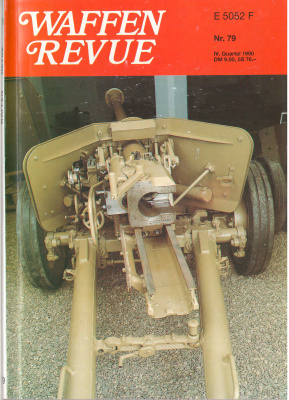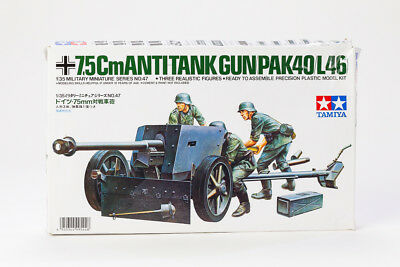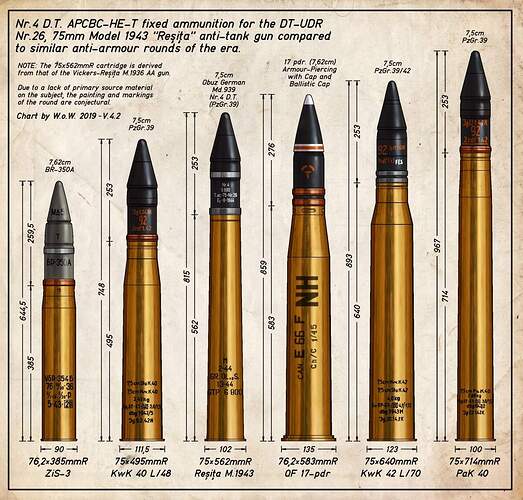Good day fellow forum members,
A while ago I had posted a topic here that I was wanting to study artillery.
For future projects.
Since then, I’m thinking that I got stuck with this.
It simply is to broad and to time consuming to study the subject in his broad entirety.
I know you have said this to me when I posted about this topic some time ago.
Now I’m in need of some help.
I’m wanting to study the AT guns of the Germans in World War II.
Especially the Pak 40 got my attention.
And I’m wanting to get more to know about it’s combat uses and experiences.
How it was manufactured, how effective it was.
And I’m willing to purchase books for this topic, if the informations I want to know are not readily availlable on the internet.
What I’m meaning by this is, that it must not be to time consuming to find specific details and information.
I don’t want to sit hours in front of my computer.
I prefer books for that matter.
I must apologize if I’m not giving all the information required to help me out with this topic.
I’m a little tired and I’m having a new keyboard and mouse that I have to get used to.
That is why my reply’s and topics may be of a little lower quality than you used to from me.
Thanks in advance for replying.
Well, studying something properly inherently means timeconsuming.
As for printed information sources, Waffen Revue always provides a wealth of real indepth information. You’d have to look into which publication on their years long series holds that info.
A quick search already yielded results for me:

Journal-Verlag Schwend GmbH, 1990. — 160 s.
Gesamtregister von Heft 1 bis Heft 79
Maschinenpistole SS 42
7,5-cm-Pak 40/2 auf Sfl „Marder II“, Teil 3
Die 7,5-cm-Pak 40
Die 5-cm-Kampfwagenkanone, Teil 3
Leichter Ladungsträger „Goliath“, Teil 5
Die Flakrakete Hs 117 „Schmetterling“, Teil 7
Die erste Selbstfahrlafette der Welt „Gun Carrier Mk I“
Titelbild: Die 7,5-cm-Pak 40, von hinten.
Standort und Foto: Wehrtechnische Studiensammlung des BWB, Koblenz.
1 Like
Thank you for your reply.
I must add to my topic that I’m only able to read Dutch and English.
I’m not able to read German.
I know that studying something properly consumes time, but I’m stuck in the sence that I’m just not wanting to read any further.
I have lost the interest for the broader topic and I’m seeing now that I’m having to narrow my vision down to more specific topics.
That would be more efficient and less time consuming.
Time is another important, highly valued resource that I want to spend wisely.
And that meant that I need to make choices such as this one.
May I ask on what you have searched to get such results?
Thank you for providing this first interesting and crucial entry point for my study.
I know the Waffen Revue publications and it was the first thing that came to mind.
And if you lost interest, just drop the subject. See what does hold your interest enough to lay down time studying it.
Fish Or Cut Bait
In other words, stop vacillating and act on it or disengage from it.
Buy a cheap Tamiya Pak40, its simple to built and easy to paint it. You can refine you airbrush skills & address you Pak40 skills at the same time.

If you’re still interested in the PAK 40, buy some books for additional info and or get the Dragon Pak 40 which is a new more detailed kit.
BTW - the PAK 40 was a very good anti-tank gun. In World War Two, it was quite capable of turn any T-34 or any Sherman (except a Jumbo) into a burning wreck from a good range from the front.
Half of the reputation of the famed 8.8cm anti-tank gun was created by far more common PAK 40. Basically, any Allied tank was vulnerable to it at typical combat range except for M26 Pershing,
JS-2 and similar heavy tanks or heavily armored tanks like Sherman Jumbo. At nearly point blank range in theory it could even knock out a JS-2 front the front with the rare special ammo.
WW2 German Anti-tank Gun Ballastics
PAK40 wiki
1 Like
Thanks for replying.
You may be right, maybe it is just best to abandon the subject all together.
Or maybe, just let it rest for some time.
And when the time and interest arrises again, still pick up the subject.
I will also try to title my topics better.
And to think and prepare before I’m going to place another topic.
Plus, I can spend my time on other things as well.
Thanks again for replying.
I must disagree with your comments on the M4a3e8 verses the 75mm round from the PAK 40 or really the L48 or L70 75mm rounds. It’s commonly known that the Soviet IS2 had the thickest armor out there, and the Panther could punch right thru it at 800 meters (front back side or whatever). Albeit far easier from the side! (like most tanks). The tungsten cored round was even better at punching holes (I have to assume the the Germans and the Allies were all going in that direction). At the time it was pure energy doing the work (don’t think HEAT existed). This is nothing new and is really a late first and early second semester physics project with a little second semester Algebra thrown in there to make you sweat.
The cartridge cases vary quite a bit in the picture, but that’s also misleading. The case will hold the propellant; be it gun powder or Cordite. The burning rate of the powder will determine the pressure behind the base of the projectile. It’s really just gas pressure in gun powder for the last hundred twenty years (black powder used an explosion to propel the projectile). This also brings you into another Physics II lesson I might add (pneumatics). Barrel length will create more pressure due to resistance of the round passing thru the barrel, and create a higher velocity. Plus it will handle a slower burning powder better; giver even more pressure (we are not talking power here). Still the actual case size can be too big, This erodes the rifling and throat in the chamber with a loss in accuracy. Just to add into this, there also is the square inches of size in the base of the round. That’s why a round that bigger in diameter and somewhat heavier seems to over achieve. You have a greater pounds of pressure per square inch even though the powder charge is of similar pressure. To make that simpler think ten square inches of area, verses 12 square inches of area. You have about 20% great area to propel the round.
Then you get into the actual shape and structure of the round. (this is known as the ballistic coefficient). Extremely important! The higher the factor number, the greater the retained velocity down range (weight is not a serious factor here). A U.S. 50 caliber machine gun round weighs 750 grains, but also has close to a 1.0 B.C. number (I still don’t believe that). On the other hand a .338 Lapua sniper round can have a .7 B.C. with a little higher velocity. The trajectories are actually quite similar; as well as energy (retained energy). Both are deadly accurate, but both are starting to get into that overbore condition (low barrel life and a loss of accuracy). In Physics and Algebra you learn that the same B.C. and similar velocities travel about the same. What I’m saying here is case size often means little. When punching a hole thru 125mm of armor plate the actual construction of the round has more to do with it than anything else (look at the dart [2.25"] shot out of the 120mm gun on a tank). A 4000fps round in WWII would go thru most anything but the side armor of a battle ship. What velocity a PAK 40 achieved I cannot say, but I’m guess it was in the 3300 to 3600fps range. In that time frame that’s really moving. An 88mm with a 50mm SABOT was way over 4000fps! Just pure kinetic energy.
gary
2 Likes
@Gary_Totty1 Gary,
I think we’ll be pretty much on the same point of view overall if our nomenclature matches. The heavily uparmored Sherman was what I was referring too. I’m by no means a Sherman-holic but there were some that had a lot of extra armor piled onto the glacis. Occasionally one finds info of this up armor package deflecting an 8.8cm AT round etc. I think there ~200 or 250 or so of them. My Sherman friends called them Jumbo’s maybe there’s another more precise name.
I don’t believe I said anything about the typical M4A3E8 being able to withstand being hit by a PAK40.
M4A3E8 easily knocked out by a PAK40.
Jumbo with the extra frontal armor not so easy for a PAK40 to deal with at range.
PAK 40 is the L46 gun it is not equivalent to the Panther’s L70 on penetration etc. Far more comparable to the Pz IV’s L48.
1 Like
I may well have misread your post, and for that I must apologize. Your comparison with the PAK 40 verses that L70 is quite correct, and it once again goes to kinetic energy on impact and construction of the projectile. You gain some velocity due to the longer barrel, but you also add to this with more propellent for an even higher gain in velocity.
The issue with the added armor is in making the round go off earlier than the ideal point. If there is any serious gap between them (even an inch) the round is done before it enters the hull itself. Later in life we (and some others) learned even better ways to make this happen. Some things seem crude, but still work. Example is simple Styrofoam sandwiched between two layers of metal (perhaps four inches thick block of foam. It was found out by accident that it caused an RPG war head to expend itself way ahead of time, and also worked against some others as well. Then there were the sand filled passive blocks that pretty much worked the same way. Spaced armor is the arch enemy of deep penetration.
gary
2 Likes
As I’m reading through your commentaries, I’m understanding why Im having so much difficulties with this subject.
There is a lot more technical stuff going on in the background.
Things that I’ve never learned before, things I dont understand to be honest.
But I must also say, I’m more interested in combat history.
How it was produced.
Still, a very interesting topic I suppose. Even if Im not understanding much of it.
1 Like


